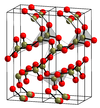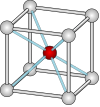正負離子半徑比
外觀
正負離子半徑比或陽陰離子半徑比(英語:Cation-anion radius ratio)是在凝聚態物理和無機化學中用來預測離子化合物晶體結構的參數。其定義為離子化合中帶正電的陽離子半徑與帶負電的陰離子半徑的比值。通常情況下,陰離子的半徑比陽離子半徑大,因此常是陰離子占據晶格位點,陽離子則填充陰離子之間的空隙,因此可以根據幾何關係預測晶體的結構。該法則是鮑林法則中的第一規則[1]。在給定結構下,可簡稱為半徑比。
半徑比規則與穩定性
[編輯]
半徑比規則是指根據離子的配位方式的不同,每種配位方式存在一個臨界的半徑比[2]。其思想是將離子化合物中的陰陽離子視為不可壓縮球體,意味著陰陽離子兩種大小不同的「球」發生不等最密堆積,在給定結構下允許的陽離子大小範圍由臨界半徑比決定[3]。如果陽離子太小,被吸引過來的陰離子之間會發生接觸,由於同種電荷相互排斥,這種情況下其結構不穩定,也就是說當半徑比下降到該特定結構的臨界半徑比以下時,就會發生這種情況。在剛好處於穩定極限時,陽離子接觸所有陰離子,而陰離子只接觸它們的邊緣。對於大於臨界半徑比的半徑比,結構預計是穩定的。
然而並非所有化合物都遵循這一規則。據估計,晶體結構只有約2/3的情況被這一規則猜中[4]。產生這種誤差的原因是實際上化合物離子之間並非完全是離子鍵,有時會帶有一定共價鍵成分[2]。
下表列出了臨界半徑比與配位數之間的關係,從簡單的幾何學關係,可以得到下式:[5]
| 臨界半徑比 | 配位數 | 間隙類型 | 晶體結構 | 示例 |
|---|---|---|---|---|
| 0.1547 | 3 |  平面三角 |
 α-B 2O 3 結構 |
B2O3 |
| 0.2247 | 4 |  正四面體 |
 閃鋅礦結構 |
ZnS, CuCl |
| 0.4142 | 6 |  正八面體 |
 岩鹽結構 |
NaCl, MgO |
| 0.7320 | 8 |  立方體 |
 氯化銫結構 |
CsCl, NH4Br |
歷史
[編輯]正負離子半徑比最初由Gustav F. Hüttig在1820年提出[6][7]。1926年戈爾德施密特將其推廣到離子晶格中[8][9][10]。1929年,這一規則被合併到描述晶體結構的鮑林法則中,並作為當中的第一條規則[11]。
相關條目
[編輯]參考文獻
[編輯]- ^ 梁敬魁. 相图与相结构. 北京: 科學出版社. 1993. ISBN 9787030031624.
- ^ 2.0 2.1 Michmerhuizen, Anna; Rose, Karine; Annankra, Wentiirim; Vander Griend, Douglas A. Radius Ratio Rule Rescue. Journal of Chemical Education (American Chemical Society (ACS)). 2017-08-09, 94 (10): 1480–1485. ISSN 0021-9584. doi:10.1021/acs.jchemed.6b00970.
- ^ Pauling, Linus. Nature of the Chemical Bond 3rd. Ithaca, New York: Cornell University Press. 1960: 544. ISBN 9780801403330.
- ^ Nathan, Lawrence C. Predictions of crystal structure based on radius ratio: How reliable are they?. Journal of Chemical Education (American Chemical Society (ACS)). 1985, 62 (3): 215. ISSN 0021-9584. doi:10.1021/ed062p215.
- ^ Toofan, Jahansooz. A Simple Expression between Critical Radius Ratio and Coordination Number. Journal of Chemical Education (American Chemical Society (ACS)). 1994, 71 (2): 147. ISSN 0021-9584. doi:10.1021/ed071p147. (and Erratum 71(9): 749 doi:10.1021/ed071p749), Following the erratum, equations should read and .
- ^ Jensen, William B. The Origin of the Ionic-Radius Ratio Rules. Journal of Chemical Education (American Chemical Society (ACS)). 2010-04-23, 87 (6): 587–588. ISSN 0021-9584. doi:10.1021/ed100258f.
- ^ Hüttig, Gustav F. Notiz zur Geometrie der Koordinationszahl. Zeitschrift für anorganische und allgemeine Chemie (Wiley). 1920-11-11, 114 (1): 24–26. ISSN 0863-1786. doi:10.1002/zaac.19201140103 (德語).
- ^ Goldschmidt, V.; Barth, T.; Lunde, G.; Zachariasen, W. Geochemische Verteilungsgesetze der Elemente. VII. Die Gesetze der Krystallochemie. Oslo: Dybwad. 1926: 112–117 [2024-07-09]. OCLC 174577644. (原始內容存檔於2023-06-29) (德語).
- ^ Goldschmidt, V. Geochemische Verteilungsgesetze der Elemente. VIII. Untersuchungen über Bau und Eigenschaften von Krystallen. Oslo: Dybwad. 1927: 14–17. OCLC 19831825 (德語).
- ^ Goldschmidt, V. M. Crystal structure and chemical constitution. Transactions of the Faraday Society (Royal Society of Chemistry (RSC)). 1929, 25: 253. ISSN 0014-7672. doi:10.1039/tf9292500253.
- ^ Pauling, Linus. The principles determining the structure of complex ionic crystals. Journal of the American Chemical Society (American Chemical Society (ACS)). 1929, 51 (4): 1010–1026. ISSN 0002-7863. doi:10.1021/ja01379a006.








